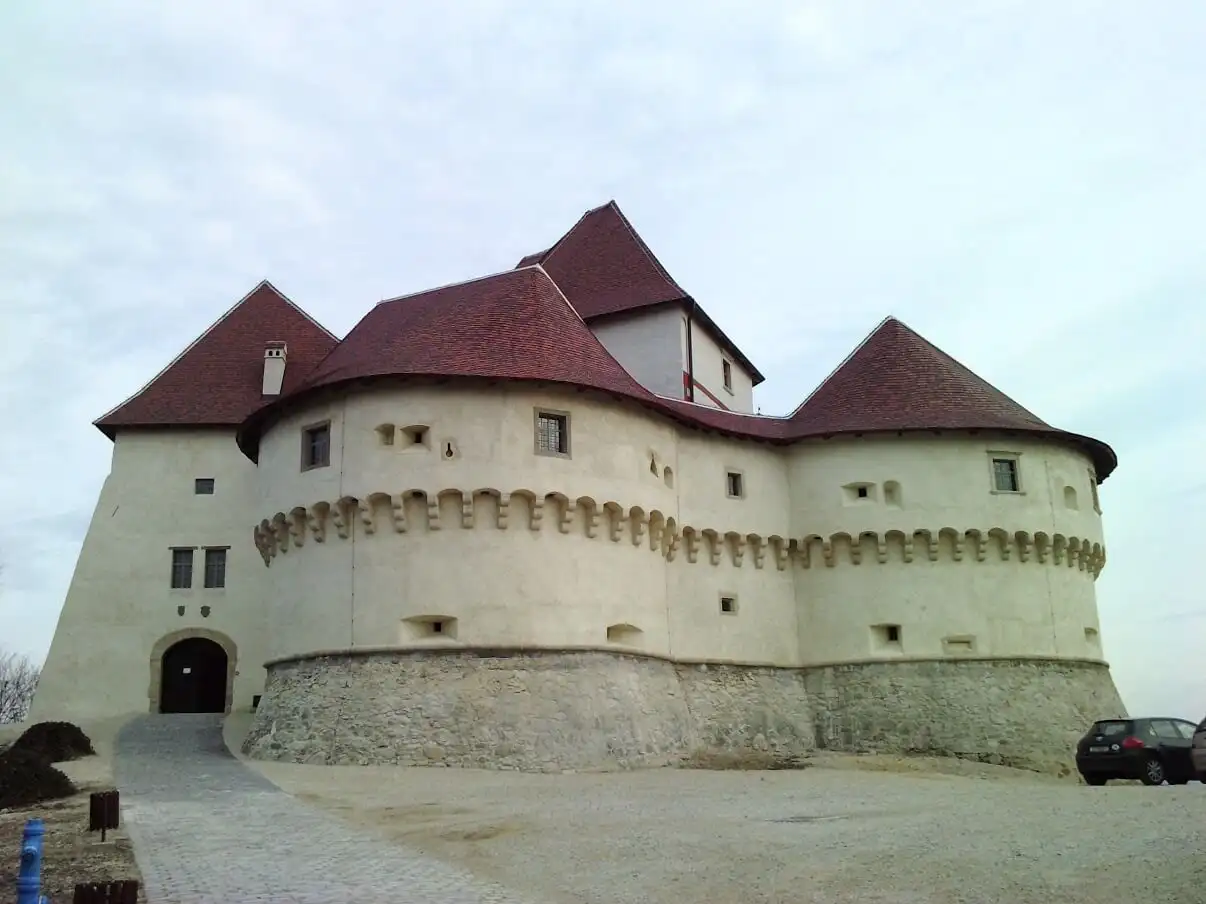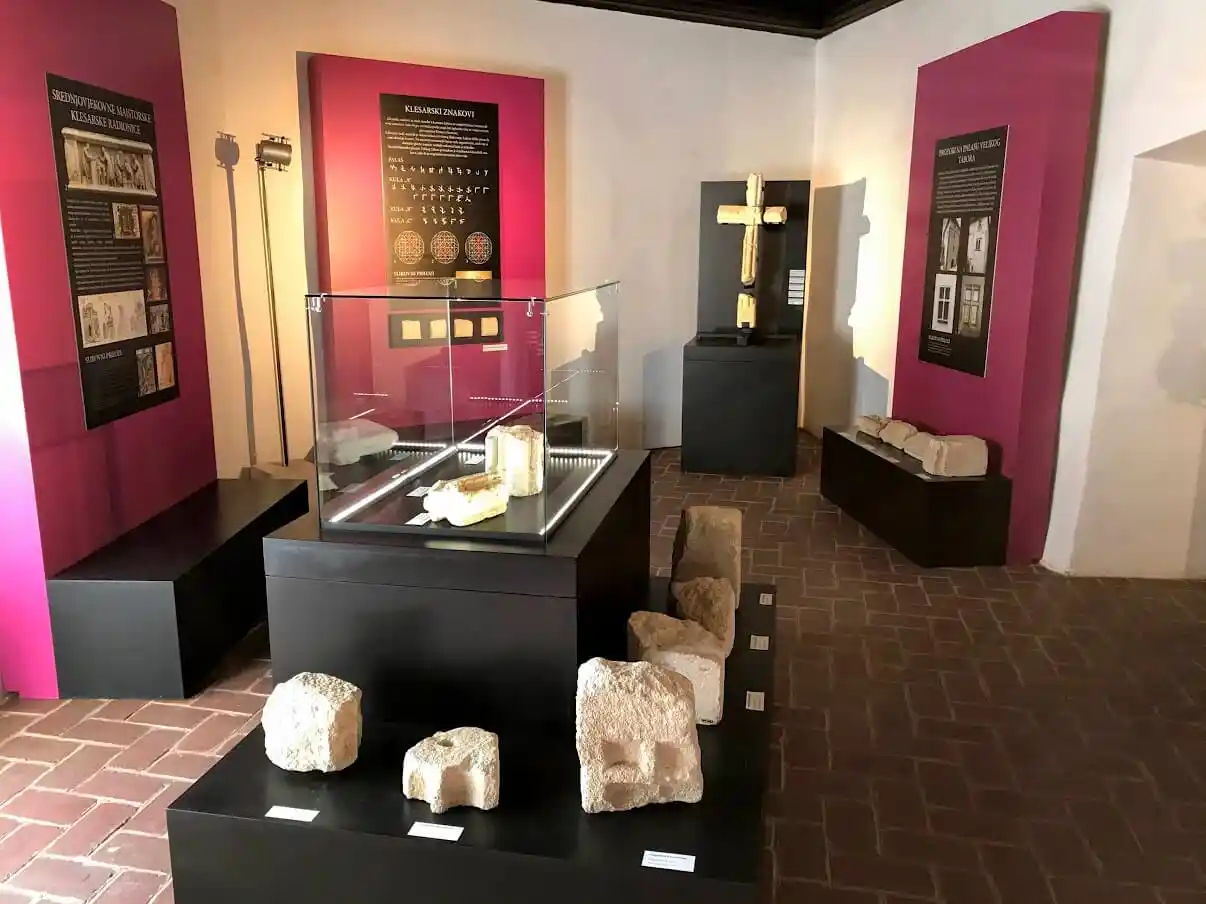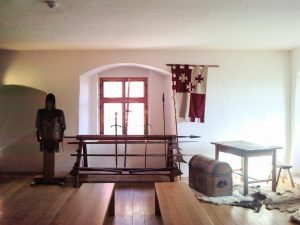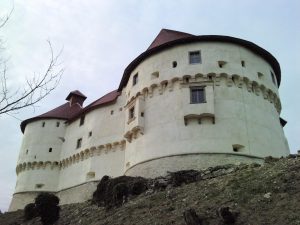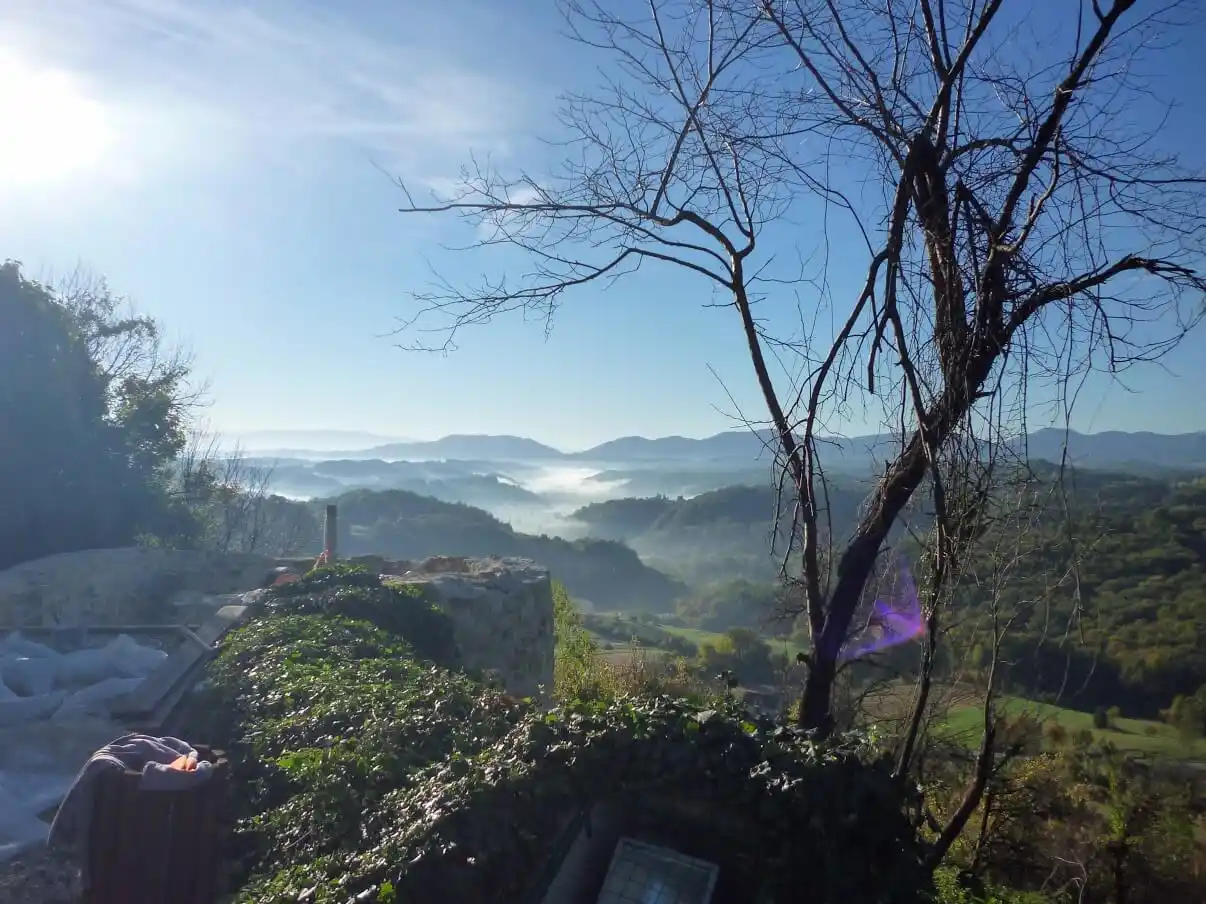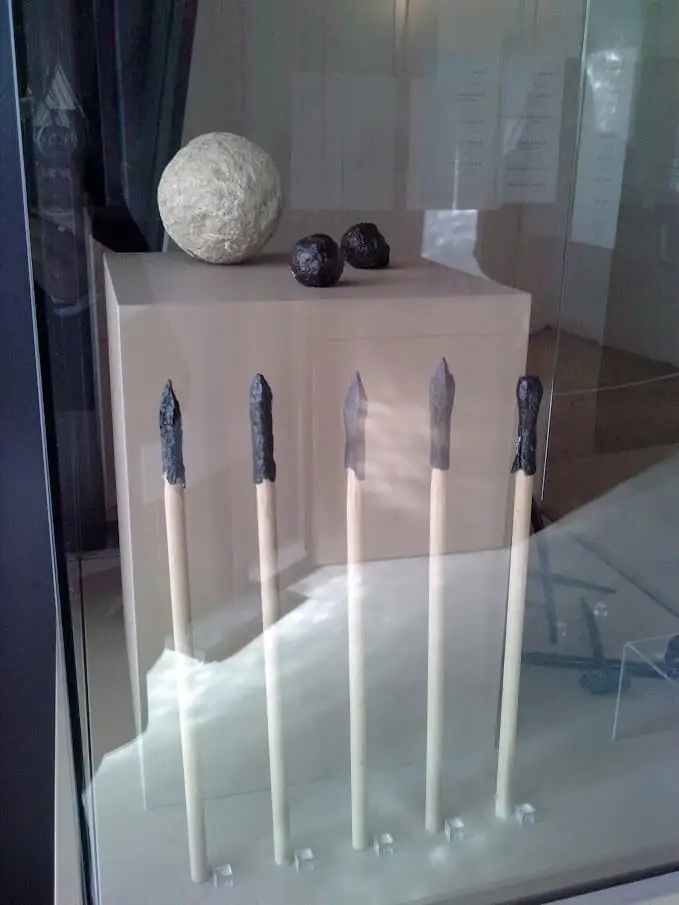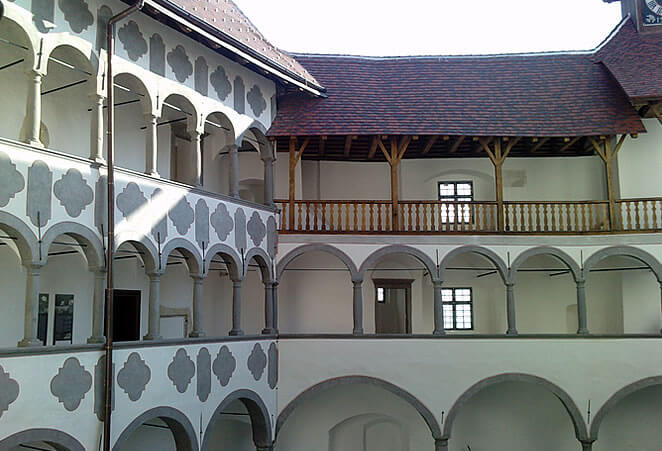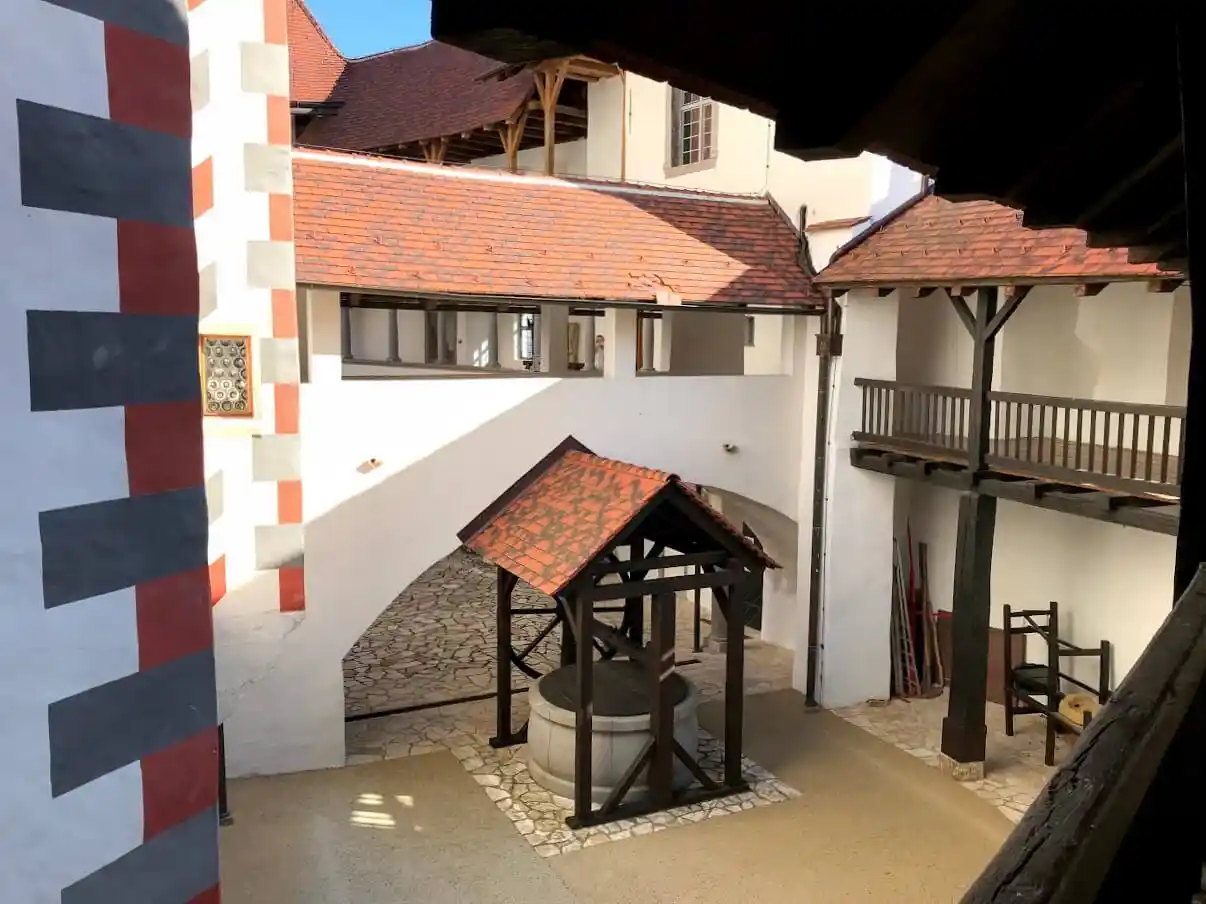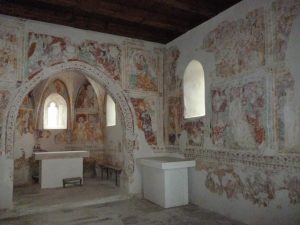Veliki Tabor Castle is one of the best-preserved and most beautiful medieval fortresses in Croatia. It’s located in the Hrvatsko zagorje region, known for numerous beautiful historical castles. It was thoroughly restored a few years ago, so now it shines with a new light. Here is an overview of Veliki Tabor Castle’s history, legends and things you shouldn’t miss while visiting that fantastic place.
Veliki Tabor Castle
I did an internship in Veliki Tabor Castle almost ten years ago, and it was a perfect place for the first job. So here, I’m sharing some well- researched facts and some insider tips with you.
The Veliki Tabor Castle is located in the northwestern part of Hrvatsko zagorje province, some three kilometres from a small village called Desinić. It will take you a bit more than an hour to get there from Zagreb by car.
Its name comes from the word tabor, describing a war camp or fortifications used as protection against Turkish invasions. The word veliki in Croatian means large, so it could literally be translated as a large military camp.
⤷ Read more: Exploring the Hrvatsko zagorje region of Croatia
What to see in Veliki Tabor Castle
Veliki Tabor Castle is a museum today, and there is lots to be seen there. You can take a walk around the castle first and enjoy in some lovely views of the hills of Hrvatsko zagorje.
There is a permanent exhibition in a museum, where you can learn more about how the castles were built during the Middle Ages, historical furniture and weapons, Veliki Tabor Castle owners and archaeological findings.
The museum is also organising regular temporary exhibitions, so there’s always something new to be seen there.
⤷ Read more: History of travelling
History of the Veliki Tabor Castle
The researchers are still not sure who and when built the Veliki Tabor Castle. Some think it was made in the second half of the 15th century. While others claim its construction happened at the beginning of the 16th century.
However, the fact we know for sure is that the Veliki Tabor Castle was first mentioned at the grant certificate by Ivaniš Korvin in 1502. He gave the castle to Pavao Rattkay for his efforts in the battles against the Turks. But also to square a debt of two hundred forints that he owed to Rattkay.
⤷ Read more: Best places to visit in Croatia
Who owned the Veliki Tabor Castle
After getting the Veliki Tabor Castle, one branch of the Rattkay family moved from Hungary to Croatia. They remained living in Hrvatsko zagorje until the end of the 18th century, when the last member of the family died.
With time, the Rattkay family become more and more important in noble circles. They were granted barony in 1559 by Emperor Ferdinand II and a title of counts in 1687 by Leopold I. The family was the most powerful during the 17th century.
Besides Veliki Tabor Castle, the Rattkay family owned several other castles in the Hrvatsko zagorje region and surroundings. Some of them were Mali Tabor, Jurketinec, Miljana, Velika Horvatska, Druškovec, and parts of Donja Stubica, Susedgrad, Klenovec and Golubovec.
When the last Rattkay died in 1793, Veliki Tabor Castle became the state property. It was taken over by the Imperial Chamber and given to the minister of external affairs, count Thuguth. After he died, Veliki Tabor was once again under state jurisdiction. Later on, its owners became Zagreb merchants, the Grünewald brothers. After it, during World War One, fortification was used as a prison.
From 1919 to 1938, its owner was a famous Croatian painter, Oton Iveković. He bought it to preserve it from deterioration. But, because of the high price of city maintenance, he was forced to sell it. Veliki Tabor Castle was then granted to the Order of St. Claire. They turned it into an orphanage and divided its residential areas into smaller rooms, adjusting them to their new function.
After they moved out, Veliki Tabor Castle was used for some completely inappropriate purposes, such as the meat drying facility or an agricultural union quarters.
However, in 1993 it was taken over by the Museums of Hrvatsko zagorje. Soon the archaeological research started. It provided more information about Veliki Tabor Castle’s history and changes happening in its architecture throughout time. Based on those researches, conservation work started. After a few years, Veliki Tabor Castle was restored and became one of the best-preserved and presented medieval castles in Croatia.
⤷ Read more: 20 Archaeological sites you have to visit in Europe
Veliki Tabor Castle Architecture
The Veliki Tabor Castle consists of the central pentagonal tower surrounded by four semi-circular towers connected by the residential structure. All of that is surrounded by another defensive wall with smaller towers on it.
Central pentagonal tower
The oldest part of the Veliki Tabor Castle is the central pentagonal tower. By its architectural style, it belongs to the late Gothic period.
Initially, it consisted of the ground level (wine cellar) and two upper floors. There is a funnel in the centre of the tower, with fireplaces and a tile stove connected to it on upper floors.
In the beginning, the fort was surrounded by wooden palisades that strengthen its defence. After some time, the third floor was added. It was first used as a granary and transformed into a residential area later on.
The original glazing was reconstructed on the windows of the central turret. A medieval toilet was also preserved inside the northern wall of the second floor, which is quite a rare finding of this type still being in its original place.
Complex with four towers
The ring, composed of four semi-circular towers, was built around the mid-16th century. They were connected by the walls with residential areas and the entrance wing.
By expanding the castle, wooden palustrades weren’t needed anymore. This new architectural complex had a defensive role, as well.
Two western semi-towers were built first since the castle was the most vulnerable from that side. The firearms were already in use by that time. So the shape of these towers reflects that. The towers are curved outwards towards the bottom, which prevented sapping or mining the walls. At the same time, stones, hot water and tar, thrown out through the drains, could bounce off at the attackers.
There is a cordon cornice on the exterior side of the towers, marking the ground level of the castle’s interior.
The south tower is home to Saint Peter Chapel. It’s pretty interesting because you can see the original arrangement of loopholes and small windows in its walls. The eastern tower is the largest and was initially two floors high.
In the inner courtyard, the towers are connected by beautifully decorated arcades. The central building got a Renaissance bifora window in the second half of the 16th century. It is most likely that the stone staircases leaning on the palace were also built in that period.
Outer defensive walls
The inner core of Veliki Tabor Castle was enclosed by another outer defensive wall. It encircled the entire hill’s plateau on which the castle stood. On the westernmost part of it, there was an entrance tower.
South of it was a bastion with artillery loopholes, providing evidence of an active town defence. There were smaller towers on both the south and west sides of the plateau. However, they are in an archaeological state of conservation today.
⤷ Read more: City Guide Varaždin
Archaeological research in Veliki Tabor Castle
Unfortunately, no original furniture from Veliki Tabor Castle is preserved today. Some traces of the objects used in the castle were found during the archaeological excavations performed there from 1995 onwards. The research mostly revealed ceramic objects and, in smaller fragments, some fully preserved tiles from the tile stove, along with some ceramic pottery.
The tiles shed some information on the heating principles of a late medieval castle. Judging by their diversity, there were several tile stoves in Veliki Tabor Castle. Among the samples of preserved pottery, we can distinguish dishes used to prepare and conserve food from finer ones used as table dishes. Apart from the ceramic ones, fragments of glass and majolica objects were preserved, though those were primarily foreign imports.
The research also revealed a group of objects used in warfare, such as arrow tips, stone scoops etc., and some objects used in everyday life in the castle (e. g. needles, hooks etc.).
⤷ Read more: Medieval frescoes in Istria
Some tips for visiting Veliki Tabor Castle
⤷ How to get there – Veliki Tabor Castle is located in the northwestern part of Croatia. The best way is to visit it by car. You’ll need a bit more than an hour to get to the Veliki Tabor Castle from Zagreb. It’s located just outside the village Desinić.
⤷ Where to eat close by – A nice restaurant with a great view of Veliki Tabor Castle is located just a few minutes from the castle. It’s called Grešna gorica. It could be pretty popular on weekends, so be sure to book your place in advance.
⤷ Where to park – There is a large parking space in front of the castle, so you can leave your car there.
⤷ Veliki Tabor Castle opening hours – the museum opening hours could vary depending on a season. To be sure when they’re open be sure to check out their website for the updated info.
Veliki Tabor Castle legends
Veliki Tabor Castle is filled with some exciting legends. From the ghosts that haunted it, strange groans on stormy nights, a skeleton procession, the cursed chaplain, to the midnight banging on the city walls etc.
However, the most famous of them all is the Veronika of Desinić Legend. It originated a long time ago when the mighty count Hermann II of Cilli ruled these lands. While riding around the Veliki Tabor Castle, Hermann’s younger son Frederick met a beautiful local girl – Veronika. They have fallen in love immediately. However, Frederick was already married to Elizabeta Frankopan, a member of another important noble family. Since they no longer lived together, Hermann and Frankopans arranged a meeting of spouses in the city of Krapina. They hoped the two will reconcile. However, the following day Elizabeta was found dead. The rumour was Frederick himself murdered her, but that was never proven correct.
Following these events, Frederick and Veronika fled to the Fridrichstein Castle in Slovenia, where they secretly married. Count Hermann found out about the wedding soon and sent an army to capture the lovers. Frederick managed to get Veronika out of the town and sent her to hide in the small village of Sveta Margita. However, he was unable to do the same. He was captured by his father’s soldiers and prisoned in the Cilli Castle in Slovenia. The tower in which he was imprisoned is still called Frederick’s Tower. He spent four years there, and when finally released, he was mentally broken.
Veronika didn’t have any better luck. After some time, Hermann’s soldiers found her as well. They have taken her to the Veliki Tabor Castle for a trial. She was accused of being a witch who seduced Frederick. A trial lasted for two days, and on the evening of the second day, the judges decided she is not guilty.
But, Hermann wasn’t satisfied with that verdict. So as soon as the judges left, he ordered his servants to drown Veronika. They sealed it inside the wall that connects the pentagonal tower with the castle’s entrance to hide her body. They say you could still hear the silent cries of poor Veronika today, especially during the long windy winter nights.
Here is a video about the Veronika of Desinić legend (you may see some familiar faces in it):
Sveti Ivan in Ivanić Miljanski Chapel
Some recent findings proved this legend isn’t only a story. Recently, some interesting wall paintings were discovered in the close-by Chapel of Sveti Ivan in Ivanić Miljanski. Throughout the research, it was found they were created in the 15th century and most probably commissioned by no one else than Frederick of Cilli. Several painted figures were recognised as protagonists of this legend: Frederick, Hermann, Veronika, Ivan Frankopan etc. It seems the chapel was built and painted to mark the legalisation of the son Frederick had with his second wife Veronika of Desinić in 1447.
Veliki Tabor is one of the most beautiful castles in Croatia and a great example of a medieval fortification. Paying a visit to it could be a great thing to do while visiting the northern part of Croatia.


